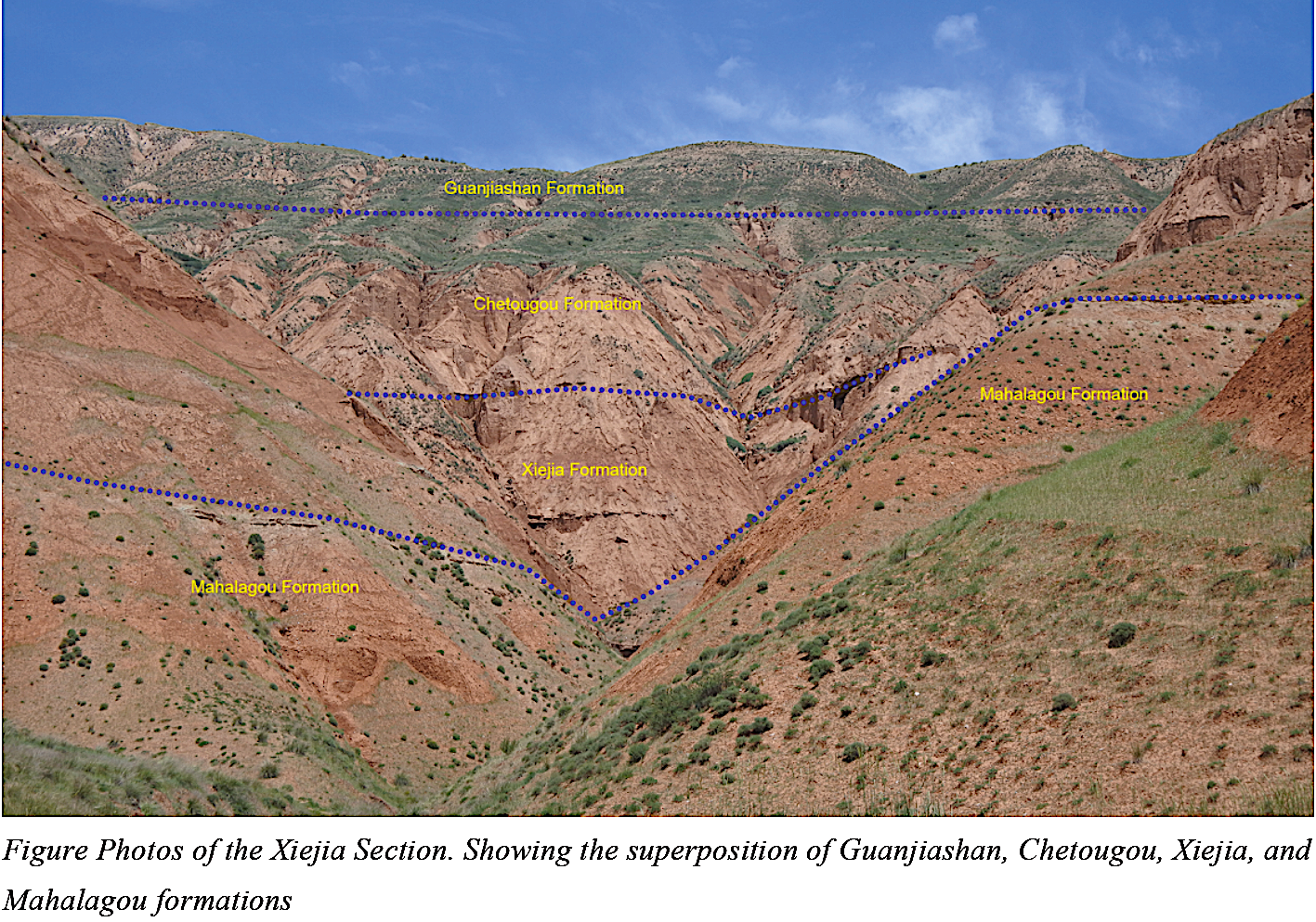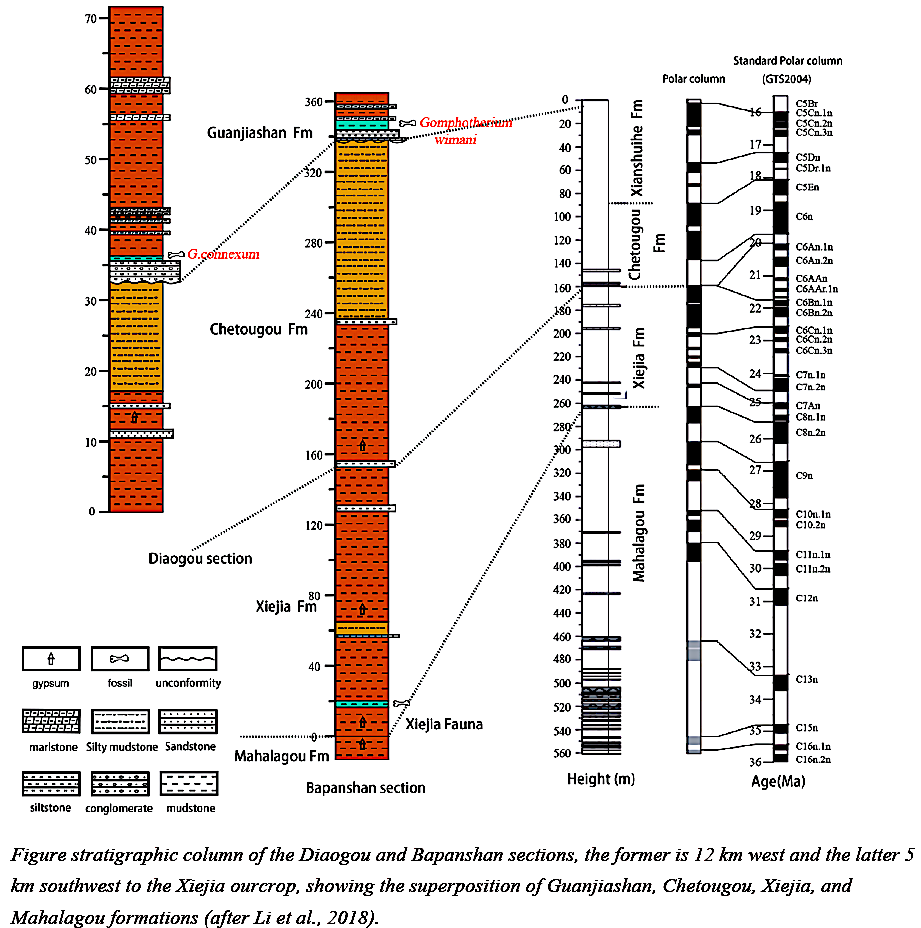Xianshuihe Fm
Type Locality and Naming
Lanzhou (Xining). The naming section (type no assigned), Xiajie section, is located at the Xiajie (formerly Xianshuihe) Village, Shuping Township, Yongdeng County, Lanzhou City. It is located 18 km southwest of the Lanzhou Zhongchuan Airport, 46 km southeast of the Yongdeng County. Geographical coordinates: 36°22′31.31″N, 103°30′59.00″E (GPS). The naming of the Xianshuihe Formation is very early in the history of the Chinese stratigraphy (Young and Bien, 1937)
Synonym: Recently, the synonymous strata from the Xining Basin was renamed as the Guanjiashan Fm (Fang et al., 2019).
Lithology and Thickness
It is composed of three major sedimentation cycles, which are separated as three members: The Lower Member is characterized by the massive pale reddish brown to light-moderate brown claystone with intercalated siltstone of paler color. The member always starts with a basal layer of dusky yellow conglomeratic sandstone, disconformably overlying the Yehucheng Formation. The sandstone, called the Yellow Sand, is poorly sorted, often cross-bedded, containing large amounts of anguclasts. It can easily be recognized not only for its peculiar color, but also for its richness in fossil plant stems, which are apparently iron-manganesed and black in color. It is the best marker bed of the base of the Xianshuihe Formation. The upper boundary of the Lower Member in the Dahonggou section is rather arbitrarily defined, based on the occurrence of the first thick layer of the White Sand at a level of 1137.21 m measured from the base of the section. This makes the thickness of the Lower Member in the Dahonggou section to be 470.36 m. The thickness of the Lower Member measured in the Duitinggou section is only 99 m.
The Middle Member is characterized by the massive, pale reddish brown (10YR 5/4) to light-moderate brown claystone intercalated by multiple layers or lenses of white sandstone. The member always starts with a thick layer of white to very pale orange conglomeratic sandstone, the White Sand. The claystone is almost the same as that of the Lower Member, but with more sandy quality. The sand grains of the basal white sandstone are composed mainly of well-sorted and rounded quartz, often forming cross-beds of large scale. The sandstone is usually very thick, disconformably overlying the Lower Member of the Xianshuihe Formation. The typical lithology of this member is well exposed in the vicinity of the Duitinggou syncline, where it is ~225 m thick. In the Dahonggou area the separation of the Middle Member from the Lower one is difficult, since no such characteristic white sandstone as in the Duitinggou section is developed there. If the first layer of white sandstone occurred at the level of 1137.21 m measured from the base of the Dahonggou section can be correlated with the basal white sandstone in the Duitinggou section, the thickness of the Middle Member in the Dahonggou section is only 188.17 m.
The Upper Member is characterized by very pale orange and yellow sandstone and conglomerates, intercalated with pale reddish brown (10YR 5/4) siltstone and mudstone. The percentage of the sandy matrix is much higher compared with the underlying deposits. This member is so far only developed in the Xiajie section. Its top part is covered by Quaternary loess, so that its total thickness is unknown. The measured thickness in the Xiajie section is 300 m.
[Figure: Photos of the Xianshuihe Formation. A, the yellow sandstone beds in the Lower Member; B, the Quantougou Fossil locality in the Upper Member, discovered by Andersson (1925), yielding the large mammals.]
Relationships and Distribution
Lower contact
The contact with the underlying Yehucheng Fm, the gypsiferous mudstones, is unconformable. However, next older unit in these basins is the Chetougou Fm.
Upper contact
The top of the Xianshuihe Formation is covered by the Quaternary loess.
Regional extent
GeoJSON
Fossils
Nanpoping Fauna: Plants: Populus davidiana, P. simonii, P. spp., Salix sp., Rhus turcomanica Korov, ex Vassilevsk. Ulmus carpinoides, Zelkova sp., Sabaria sp. Invertebrates: Unio wendli. Cuneopsis oblonga. Reptiles: Tinosaurus sp., Plaeosaurus sp. Mammals: Lagomorpha: Desmatolagus pusillus, Ordolagus teilhardi; Rodentia: Anomoemys lohiculus, Tsaganomys altaicus, Eucricetodon asiaticus, Parasminthus tangingoli, Parasminthus parvulus, Tataromys plicidens, Tataromys sigmodon, Tataromys minor, Bounomys bohlini, Botinomys ulantatalensis, Yindirtemys grangeri, Karakoromys sp.; Perissodactyla: Schizotherium ordosium, Allacerops cf. turgaica; Artiodactyla: Paraentelodon sp. Xiagou Fauna: Didymoconidae: Didymoconus berkeyi; Erinaceidae: Amphechinus cf. rectus, Amphechinus cf. minimus, Amphechinus sp.; Insectivora: Soricidae indet.; Lagomorpha: Sinolagomys kansuensis, Sinolagomys cf. major, Ordolagus sp., Desmatolagus cf. gobiensis; Rodentia: Parasminthus asiae-centralis, P. tangingoli, P. parvulus, P. spp., Litodontomys huangheensis, Heterosminthus lanzhouensis, Sinosminthus sp. Tataromys plicidens, Yindirtemys ambiguus, Y. grangeri, Y. xiningensis, Eucricetodon sp., Tachyoryctoidesl sp., Tsaganomys altaicus. Zhangjiaping Fauna: Molluscs: Lepidodesma languitati, Lepidodesma ponderosa, Cuneopsis oblonga. Mammals: Lagomorpha: Sinolagomys kunsuensis, Sinolagomys cf. pachygnathus, Sinolagomys sp.; Rodentia: Tachyoryctoides sp., Tataromys plicidens, Tataromys sp., Yindirtemys gobiensis, Yindirtemys sp., Socialis, ISayimys sp.; Carnivora: Ictiocyon sp., Plesictis cf. vireti, Amphicyonidae gen. et sp. indet.; Creodonta: Hyaenodon sp.; Proboscidea: Proboscidea gen. et sp. indet.; Perissodactyla: Indricotheriinae, Aprotodon lanzhouensis, Phyllotillon huanghoensis; Artiodactyla: Cervidae gen. et sp. indet., Bovidae gen. et sp. Indet. Duitinggou Fauna: Lagomorpha: Sinolagomys sp.; Rodentia: Megacricetodon sp., Democricetodon sp., Heterosminthus sp., Protalactaga sp., Parasminthus sp.; Artiodactyla: Stephanocemas sp. Quantougou Fauna: Eulipotyphla: Mioechinus gobiensis; Rodentia: Heterosminthus orientalis, Protalactaga grabaui, P. major, Plesiodipus leei, Megacricetodon sp., Democricetodon sp.; Proboscideaa: Platybelodon sp.; Artiodactyla: Kubanochoerus gigas.
Age
Depositional setting
Fluvio-lacustrine deposits.
Additional Information



